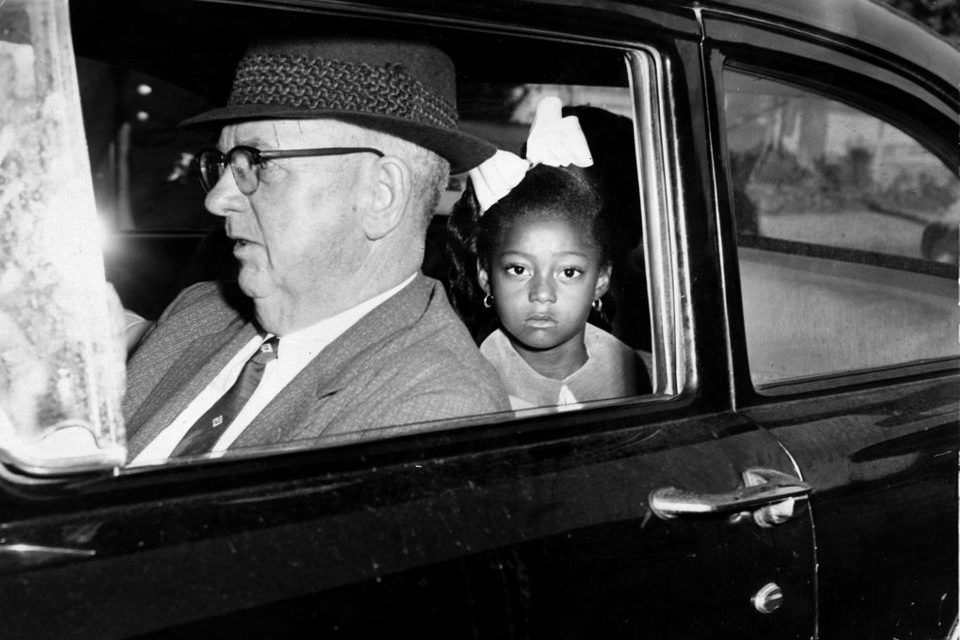OPINION
By Jarvis DeBerry
NOLA.com/The Times-Picayune, November 15, 2018 —
Deep inside the Mississippi Civil Rights Museum in Jackson, Miss., a visitor turns a corner and is confronted with a larger-than-life-size photo of two black civil rights activists arriving at a Jackson bus terminal where they know they will be arrested for entering a whites-only waiting room.
The two self-sacrificing activists – Doris Jean Castle and Jerome Smith – are New Orleanians, and the photo of them looks like it’s been snipped out of a black-and-white action movie. Smith is in stride and holds a suitcase with both hands at waist level; Castle, a purse dangling from her left wrist, holds a Birmingham newspaper in the same hand. “Riders vow…” is the only part of the front-page headline we can see. But the resolute look on their faces finishes the thought. It is obvious they vow to keep going.
Even if it means being thrown into a Mississippi jail cell.

A photo by William Lovelace from the Mississippi Civil Rights Museum taken on Oct. 26, 2018, shows an archival image of New Orleanians Jerome Smith and Doris Castle arriving in Mississippi by bus during the Civil Rights Movement. (Photo by Emma Scott, NOLA.com | The Times-Picayune)
A New Orleanian standing in that museum three hours north of here feels a twin rush of pride and embarrassment. The pride comes from the realization that the civil rights contributions of New Orleanians is recognized outside New Orleans. But that pride is quickly supplanted by embarrassment that those civil rights contributions are not properly recognized within this state.

New Orleanians Jerome Smith and Doris Castle get off the “Freedom Bus” at Jackson, Miss., May 25, 1961. The riders were protesting against the segregation of passengers on the nation’s buses. (Photo by William Lovelace/Express/Getty Images)
Alabama has the Civil Rights Institute in Birmingham. Georgia has long had the King Center for Nonviolent Social Change in Atlanta, the city where Martin Luther King Jr. was born. More recently, Atlanta became home to the National Center for Civil and Human Rights. Tennessee has the National Civil Rights Museum; it’s at the site of Memphis’ Lorraine Motel, where King was assassinated. And then in December 2017, just in time for a celebration of the state’s bicentennial, Mississippi opened the doors of the Mississippi Civil Rights Museum.
Louisiana, shamefully, has nothing.
Louisiana has nothing even though it was New Orleans civil rights activity that led to the 1896 Plessy v. Ferguson ruling, one of the most wrongheaded and consequential Supreme Court decisions in American history.
Louisiana has nothing even though a 1953 bus boycott the Rev. T.J. Jemison led in Baton Rouge inspired a larger, world-changing bus boycott that kicked off in Montgomery, Ala., two years later.
Louisiana has nothing even though Jemison and King, the leader of the Montgomery boycott, were among those who met at Central City’s New Zion Baptist Church to help start a new organization called the Southern Christian Leadership Conference.
Louisiana has nothing even though the first group of Freedom Riders leaving Washington set New Orleans as their destination; even though the photo of Ruby Bridges walking solo into William Frantz Elementary School is one of the most iconic images of the era; even though the young people who sat in at McCrory’s lunch counter in New Orleans in 1963 successfully challenged their arrests in a Supreme Court case called Lombard vs. Louisiana.
That ruling put an end to many segregationist laws across the country. And yet, there’s no museum here that recognizes the heroism and accomplishments of Rudy Lombard, Lanny Goldfinch, Cecil Carter Jr. and Oretha Castle, the older sister of the woman who’s featured in the aforementioned photo in the museum in Mississippi.

Freedom Rider Doris Castle of New Orleans is directed away from the white waiting room at the Jackson, Miss., bus station May 25, 1961. (Photo by William Lovelace/Express/Getty Images)
Bill Sherman, communications director for Lt. Gov. Billy Nungesser, said in response to an inquiry from NOLA.com | The Times-Picayune: “The Lt Gov. has not had any contact with N.O. Officials regarding a location of a CR museum. However, there have been some preliminary in-house discussions about possibly locating a room(s) in an existing museum that could host a CR exhibit. At this time, the Louisiana State Museum is struggling to keep up with repairs and maintenance at existing museums with their limited budget.”
A room inside a larger museum is not what the 1999 legislation establishes. Neither is Louisiana’s African-American History Trail, which Mitch Landrieu created when he was lieutenant governor.
Calling the museum project “an unfunded mandate,” Shauna Sanford, communications director for Gov. John Bel Edwards, blamed the “$2 billion budget deficit” Edwards faced when he was inaugurated.
“While we are making progress, funding for existing expenses is limited,” Sanford said, “which does not leave room for funding operating expenses on new projects at this time.”
Mississippi found money.

Federal Marshal Wallace Downs rides with Gail Etienne to McDonogh 19 school in New Orleans, Nov. 14, 1960. The first-grader was one of four students who enrolled in two previously all-white schools in the city. (Staff file photo, The Times-Picayune archives)
The Mississippi Legislature in 2011 approved $40 million in bonds with the caveat that half of that money be reimbursed with private donations.
Mississippi actually built two museums with a single entrance – one that tells the entire history of the state, and the other that focuses on the struggle for civil rights. An October 2017 column in The Clarion-Ledger suggests that the two-museum idea made the civil rights museum more palatable. However, it’s doubtful that even that idea would have gotten off the ground if not for then-Gov. Haley Barbour’s state of the state address in 2011.
Barbour, who was then considering running for president in 2012, said at that time: “The civil rights struggle is an important part of our history, and millions of people are interested in learning more about it. People from around the world would flock to see the museum and learn about the movement.”
And they have. Mississippi had projected that they’d get 180,000 visitors to their two museums in the first year. As of late October, they’d gotten 233,956.

Ruby Bridges arrives at William Frantz school in New Orleans under heavy guard, ending segregation on Nov. 14, 1960. (Photo by Frank Methe, Times-Picayune archives)
The June 2012 Louisiana Civil Rights Museum Planning Study compares Louisiana’s proposed civil rights museum with others around the country. A civil rights museum in New Orleans, the study concludes, should expect to do better than the one in Greensboro, N.C., because New Orleans is bigger and a more popular tourist destination. But it shouldn’t expect to do as well as the museum in Memphis, which is something like a shrine to Martin Luther King Jr.
“We are in an era when African American related history and culture is becoming more prominent in museums and venues around the country, indicating a growing interest,” the report says.
In the six years since that planning report was published, the National Center for Civil and Human Rights in Atlanta and Mississippi’s Civil Rights Museum have opened. So, too, has the National Memorial for Peace and Justice in Montgomery, Ala., a six-acre site dedicated to the more than 4,400 black people lynched in America between 1877 and 1950.
“I know I’m paranoid,” Ernest Jones said when we met to discuss the stalled progress of a Louisiana civil rights museum, “but I have an abiding sense that the enemies of my people don’t want this to exist.”

An estimated 10,000 people marched to City Hall in a peaceful protest Oct. 1, 1963. “We are marching until victory is complete in New Orleans,” said the Rev. A.L. Davis Jr., chairman of the Interdenominational Ministerial Alliance. (The Times-Picayune archive)
Multiple sites selected and rejected
Site selection has proved to be especially difficult. Initially, the old Myrtle Banks Elementary School Building on Oretha Castle Haley Boulevard was the museum board’s top choice for the museum. Turry Flucker, a branch director for the state Office of Culture, Recreation and Tourism, said in 2004, “I think the site is fantastic. It’s accessible to the public and in a neighborhood where much of the modern civil rights movement occurred.”
A feasibility study would have to be done, Flucker added, and that could take two years, maybe more. Then came Hurricane Katrina. And three years after that, a fire.
In 2011, Lourdes Moran, then the president of the Orleans Parish School Board, said the board would be auctioning off decrepit buildings. Alembic Community Development purchased the old school building for $660,000 and currently uses it to house Dryades Public Market.
In 2013, the civil rights museum board bid $8.2 million for the Louisiana Art Guild’s ArtWorks building on the corner of Howard Avenue and Carondelet Street. Though the board’s bid was reportedly $2 million more than The New Orleans Culinary and Hospitality Institute, which was awarded the building, guild board chairman Bill Hines told The Lens that the guild was not obligated to choose the highest bidder, and that the civil rights museum board’s proposed financing was less secure than NOCHI’s.

Police carry Civil Rights activist Doris Jean Castle (Scott) down the steps of City Hall in a cafeteria chair Nov. 1, 1963, during a protest by the Congress of Racial Equality. She refused to vacate the chair when ordered to do so by New Orleans police. (Staff file photo, The Times-Picayune archive)
Before Mitch Landrieu left office as mayor, Jones said, the board proposed housing the museum in the four cottages in Armstrong Park that the National Park Service has since relinquished to the city. The idea of using the Municipal Auditorium for that purpose has also been floated.
Jones, who was appointed to the museum board by Landrieu when he was mayor, said that the board has not yet had any conversations with Mayor LaToya Cantrell about the museum or where it might go.
“Mayor Cantrell is open to engagement on this issue, and welcomes input regarding the site location and any other considerations,” city communications director Michael Tidwell said. “While this project specifically has not been on our front-burner, issues of equity, social justice and taking an honest look at our history are major priorities for the mayor.”
Jones said the board’s last meeting with a quorum was in July. What was on the agenda?
“How can we get a location?” Jones said. “And how can we get some money?”
What about getting a champion, somebody with power who can get things rolling?
Jones laughed. “That should be on the agenda,” he said.

The Rev. Avery Alexander is dragged toward a police wagon Oct. 31, 1963, after he helped lead a sit-in demonstration in the City Hall cafeteria. Alexander and 14 others were jailed. (The Times-Picayune archive)
This history should be shared
The exhibit at the Mississippi Civil Rights Museum that features Smith and Castle is not really about the two of them per se. Yes, it shows their likenesses, but it’s actually an exhibit about a favorite trick of segregationists: labeling all civil rights activists communists.
At the bottom corner of the exhibit, there’s the image of an open file folder. It’s labeled “Freedom Riders,” and inside there’s an official-looking report and a newspaper headline: “RIDERS TIED TO ‘COMMIES.’ The subhead reads: “Patrol Officials Claim Communists in State.”
When Smith was shown a cell-phone photo of the exhibit in Jackson, he lit up.
“That’s Doris!” he said, remembering his fellow activist who died 20 years ago.
Smith talked about how brave the women in the movement were, how their bravery so often inspired his own. He talked about how upset he’d been during that particular demonstration. Why did he have to put on a suit and tie, he was wondering, just to get arrested?
There was no discussion about the accusation that they were communists. Smith referred to a conversation he’d had with King and how impressed King had been with Smith’s ability to express theological truths in ways that were understandable to the people they were attempting to mobilize.

New Orleanian Jerome Smith, front, leads other Freedom Riders off the bus in Jackson, Miss., May 25, 1961. (Photo by William Lovelace/Express/Getty Images)
Then he explained the method he used to connect with older folks who may have been suspicious of young people and their activism.
“Ma’am, I’m with the student movement,” Smith said he’d tell the person answering the door, “and we’re out here trying to advance the teachings of the Sermon on the Mount.” How could church-going elders say no to that?
Every conversation with Smith is a history lesson, and he seems willing to share his experiences with anybody who asks him to share it. But he can’t talk to everybody, and like everybody else’s, his time on this planet is limited.
The Legislature in its wisdom decided in 1999 that there needs to be a museum that holds Smith’s stories, and the stories of so many others in New Orleans and Louisiana who fought for the meek and who hungered and thirsted for righteousness.
In his most famous address, King imagines that “even the state of Mississippi, a state sweltering with the heat of injustice, sweltering with the heat of oppression, will be transformed into an oasis of freedom and justice.”
The state hasn’t come that far but, in 2018, we can truthfully say that even Mississippi has celebrated and commemorated its civil rights heroes.
Louisiana has done nothing.
Jarvis DeBerry is a columnist on the Latitude team at NOLA.com | The Times-Picayune. Latitude is a place to share opinions about the challenges facing Louisiana. Follow@LatitudeNOLA on Facebook and Twitter. Write Jarvis at jdeberry@nola.com or@jarvisdeberry.














